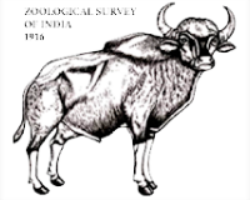
Background
India is recognized as one of the seventeen mega diversity countries of the world with four biodiversity hot spots -Western Ghats / Sri Lanka, Indo Burma, Himalayas and Sundaland. There are about 1.7 million living species described from all over the world and another 15 million species are waiting to be discovered. In India till date, 1,00,693 species of animals have been described, but a large number of species are expected to be discovered especially from the lower invertebrate groups occurring in various ecosystems. Also the status of the higher group of animals especially those in the Schedules need to be studied before their habitats get disappeared.
Scientists in ZSI are engaged in exploring, naming, describing, classifying and documenting animals from all over India. But a lot more needs to be done to understand and investigate the faunal diversity of India in the light of the objectives of the Convention of Biological Diversity for scientific use and equitable sharing of the benefits of animal resources of the country.
BIODIVERSITY CONVENTION
With reference to Articles 5, 6, 7, 8, 10, 13, 14, 17 and 18 of the Biodiversity Convention, the role of ZSI has been broadened with respect to its primary and secondary objectives as illustrated below.
IDENTIFICATION AND MONITORING (Article 7)
Very little can be done to assess the degree and value of biodiversity without knowing the species involved. The health of ecosystems also cannot be monitored without recognizing the presence of the individual organisms that are crucial for or indication of ecological processes.
ZSI has made extensive surveys in different parts of the country and large number of specimens have been collected. Of these collections only about 65% have been taxonomically studied. These include the major groups of vertebrates, while the lower groups of invertebrates need more attention in identification as well as in surveys and explorations. The backlog mainly exists due to the lack of expertise available at ZSI.
IN-SITU CONSERVATION (Article 8)
Biodiversity can be conserved by the protection of undisturbed areas, representing the variety of natural ecosystems. It means, many species yet unknown to science can be protected, and will be available for assessment for their possible utilization in future.
ZSI provides information and vital data for the in-situ conservation of various species in different ecosystems, both within and outside the protected areas.
SUSTAINABLE USE OF BIOLOGICAL DIVERSITY (Article 10)
Sustainable use is the use of components of biological diversity in a way and at a rate that does not lead to the long-term decline of biological diversity, thereby maintaining its potential to meet the needs and aspiration of present and future generation.
ZSI has been providing regular services with regard to permissible limits of legal trading of faunal resources or derivatives thereof, monitoring services on population status of commercially important species and provides input for underutilized, culturable species both from terrestrial and aquatic systems. ZSI also provides timely warning on declining population of species of commercial importance to ensure sustainable use of components of biological diversity.
ENVIRONMENTAL IMPACT ASSESSMENT (Article 14)
ZSI undertakes Environmental Impact Assessment (EIA) with special reference to ecology and wildlife.










